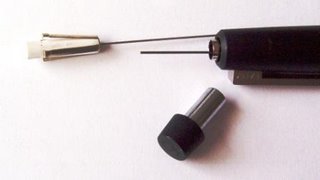ATTENTION
This Sheaffer Intrigue has a range of technically advanced features that are unique to this writing instrument. Please ensure you read the use & care guide fully before using it. Failure to do so may reduce the performance of the product.
Well, that’s what it says on the outside of the cardboard box and then you open it up to reveal this!
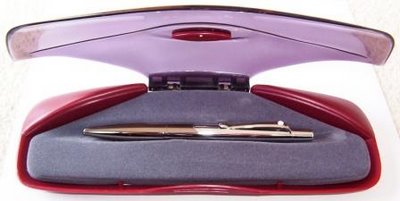
Crikey! Looks like it’s straight out of the ready-room on the Enterprise – the pencil of Captain James T Kirk or Jean-Luc Picard, but, ummm…, I haven’t graduated from NASA Astronaut school so I’m not sure I’d be capable of using this pencil with all its unique ‘technically advanced features’.
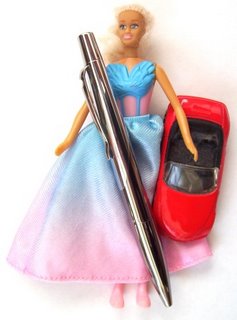
But then again, maybe it would be my entry into another life. You know, Commander Bond and I, living the live of fast cars, beautiful women, and …, international intrigue! Obviously these ‘technically advanced features’ would be fantastic stuff – electromagnetic bullet deflector, ‘knock-out’ gas dispenser, timer detonator -
WOW, life was going to be really exciting now I was a man of Intrigue.
So, time to read the ‘Use & Care Guide’. Normally of course, as a real man, I wouldn’t read the instructions until all else had failed, but with such ‘a range of technically advanced features’ this was clearly a special case. So what did this great tome of technical wizardry reveal? Well, pages of stuff in foreign languages I don’t understand, and… oh yeah, it’s an auto-advancer. There’s no knock-out gas dispenser. Ah well, dreams are free, and they say a good imagination is a healthy thing – probably even for a pencil nut.

Sheaffer was acquired by BIC in 1997. The Intrigue was released in 2000 and discontinued around early 2005, but there is still a little bit of new stock available from online retailers. Apparently the Intrigue fountain pen really was an intriguing design, and really was made in the USA.

The Intigue mechanical pencil comes in two finishes, “Whale Shark” which is a rather interesting design of light dots on a blue background, and “Satin Nickel with Palladium” which is my model. It is a two-tone bright nickel/chrome finish. The front sections are slightly darker chrome, like there is a hint of bronze in the chrome, and the upper section is in normal chrome. The only markings on the pencil are ‘Sheaffer’ around the centre and the ‘White Dot’ symbol on the pocket clip.
You know I often find the grip on shiny all metal writing instruments to be a bit of a contradiction, somehow simultaneously smooth and slippery, yet not that bad. The Intrigue fits this pattern. There is no specific grip section or enhancements so the grip can be a little slippery on the smooth metal finish, but overall it’s reasonably good. The Intrigue feels very light for its all metal construction and size.
So, onto the main event, the auto-advance system. Well, actually it is a twist action ratchet lead advance mechanism as well. The twist action is a little difficult to do one-handed as the top 2/3rds of the pencil twists around. The lead sleeve is a conical cone for writing purposes. You operate the twist action the other way to retract the cone for pocket safety. When you want to start writing you operate the twist action to pop the lead sleeve out and then you can manually use the twist action again to advance the lead or you can just start writing. The auto-advance system is quite good and smooth. Probably about as good as they get. There is very little feeling of scraping along the paper as you write, and minimal “scrape through” on existing lettering as you cross over already written lines. I enjoyed writing with it. It seems to work well with either light or heavy hand pressure, although a heavier pressure seems best. When you first start writing you don’t have to manually advance any lead out, but I seem to feel that things worked better if you did. Probably just psychological but its what I felt.
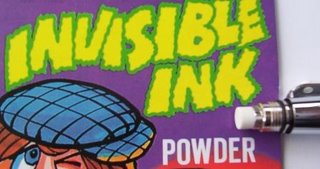
The eraser is a small to mid size one, but very hard to get at. You unscrew the very tight fitting ‘hard to unscrew’ top cap of the pencil. The cap is sealed with a rubber o-ring. No idea why. Waterproofing doesn’t seem to be a requirement for the pencil. You refill the lead chamber via a hole under the eraser. It is a small hole so you can really only feed in one lead at a time and you can’t see how many leads are in the chamber or simply turn the pencil upside down so they fall back out for you to check. Basically its a 'go in and stay in' system. The leads are 0.7mm size. The lead loaded in the pencil by Sheaffer seemed a good quality lead, but these days Sheaffer don’t offer refill leads and neither their literature nor website recommend any particular brand of leads. I contacted Sheaffer customer services to ask what leads they recommended as refills, and they replied any reputable brand, e.g. Pentel or Parker.
Despite the lack of electromagnetic bullet deflector or knock-out gas dispenser this is a pencil worthy of inclusion in any serious collection.
- Best Points – The auto-advance system.
- Not So Good Points – Ridiculously difficult to get at eraser.
- Price Range – High, but clearance specials available.
Dimensions – Length 138mm, diameter 11mm at widest point. Balance point about 70mm up from the tip.













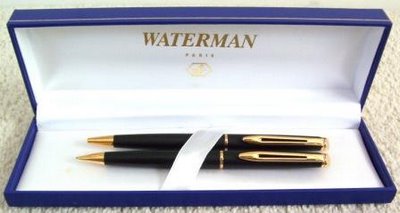









 The body of the Lamy 2000 is made from fibreglass-reinforced Makrolon, that’s Bayer’s brand of polycarbonate, so it’s the good stuff from the world of engineering plastics. Excellent toughness and stability, they make ‘bullet-proof glass’ from polycarbonate. The 2000 has a ‘brushed’ finish which gives it a very nice feel in the hand. Smooth yet not, it’s a very tactile experience - almost a ‘wood’ sort of feel. A fellow employee came into my office the other day and in the middle of a rather animated discussion wanted to draw me a diagram, so he grabbed the pencil off my desk, and just came to a halt. “Wow, this is a nice pencil” as he ran it through his fingers. I made a deliberate point of getting it back from him after he had finished the diagram. “Mine” I said, “This one doesn’t go walk-about”. The brushed finish also means the grip is pretty good on this pencil. Over time it also starts to get a little bit of a polish or patina on the area you grip it by. I’ll leave you to decide if that’s a good thing or not. Personally I’m not all that keen on it, but some folk definitely are. The tapering body also helps with the grip as you can effectively choose to grip it where it feels best. Being mostly plastic it’s not a particularly heavy pencil, but it’s still got a reasonable weight to it.
The body of the Lamy 2000 is made from fibreglass-reinforced Makrolon, that’s Bayer’s brand of polycarbonate, so it’s the good stuff from the world of engineering plastics. Excellent toughness and stability, they make ‘bullet-proof glass’ from polycarbonate. The 2000 has a ‘brushed’ finish which gives it a very nice feel in the hand. Smooth yet not, it’s a very tactile experience - almost a ‘wood’ sort of feel. A fellow employee came into my office the other day and in the middle of a rather animated discussion wanted to draw me a diagram, so he grabbed the pencil off my desk, and just came to a halt. “Wow, this is a nice pencil” as he ran it through his fingers. I made a deliberate point of getting it back from him after he had finished the diagram. “Mine” I said, “This one doesn’t go walk-about”. The brushed finish also means the grip is pretty good on this pencil. Over time it also starts to get a little bit of a polish or patina on the area you grip it by. I’ll leave you to decide if that’s a good thing or not. Personally I’m not all that keen on it, but some folk definitely are. The tapering body also helps with the grip as you can effectively choose to grip it where it feels best. Being mostly plastic it’s not a particularly heavy pencil, but it’s still got a reasonable weight to it.
